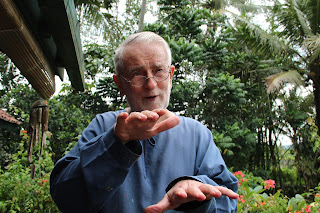A Kiwi in the paddy
The greens are darker, denser and deeper in his
homeland. Tones in his birthplace are
brighter, shriller. All are teasing, shifting, mysterious even, difficult to
catch on canvas.
New Zealand artist John van der Sterren doesn’t shrink from
the challenges of Java’s landscapes. “I have the itch,” he says and flexes his
fingers. No arthritis, though he’s 78
and spent his early childhood deprived of all essential nutrients in a tropical
concentration camp.
The awful experience scarred in other ways. “I get depressed,” he adds, “but art is also
therapy. Perseverance is very important for an artist. Deep down I know the
urge comes from up there.” He points to
the sky, but claims not to be conventionally religious.
“I’m not so prolific
now, maybe 60 paintings a year compared with more than 200 at my peak. But I can’t keep away from the studio.”
This is a splendid purpose-built building set among the rice
paddies of Central Java. It’s called Villa Sikepan (named after a nearby
village) and sits over a disused sugar-cane rail line and stone overpass known
as the Bridge of the White Tiger. Locals
claim to have seen this mythical beast so tend to keep clear.
The three-level home
stands alongside a rushing creek, one of hundreds that irrigate the Kedu Plain,
the fertile farmlands between the Progo and Elo Rivers just seven degrees below
the Equator.
It would be difficult to find a greater contrast with NZ, which
accepted the young John and his Dutch parents as refugees. They’d survived more
than three years harsh internment during the Japanese occupation of the then
Dutch East Indies
About 100,000 non-Asian prisoners filled the camps where the
death rate was up to 30 per cent. When the gates were opened after Japan lost
the war attacks by vengeful mobs hating the former colonialists took more
lives.
The family was offered repatriation to Holland or safety in
the South Pacific nation. They spent two
months in Invercargill, one of the world’s most southerly cities. Their only
child was eight.
“It was the most
marvellous time,” said the artist. “We
were made to feel so welcome.”
Back in Indonesia the returned Dutch were refusing to
recognize Soekarno’s declaration of independence and so began a guerrilla war. This only ended in 1949 when the colonialists
accepted the new post-war reality of surging nationalism.
During the four-year conflict the Dutch briefly gained some
mastery over the revolutionaries so the family returned to Indonesia where father
Albert worked in the airline industry.
But they rapidly realised the old days were over so headed back to NZ,
this time settling in the capital Wellington.
At school John was good at cartooning and keen on music,
eventually becoming a cello player with a string quartet. But art didn’t pay in
the NZ of the 1960s. “You’d be eating dog food to survive,” said van der
Sterren
So he worked with an advertising company for the next
quarter century. Along the way he got
married and had two daughters, and pushed Indonesia aside. Art stayed a weekend
pastime but became more serious when he met landscape painter Cedric Savage.
“He never taught me, but he did encourage me – and that is
so important,” said van der Sterren. “He once looked at one of my works which I
thought rather good. It had a clear blue
sky.
“Cedric picked up a brush and painted a horizontal line
through the sky. In one stroke he
changed everything.”
Then his company offered to send him to Indonesia to help
open a new office. The memories were brutal but the assignment was attractive
and Java’s beguiling colors beckoned. He
met French art dealer Didier Hamel in Jakarta who challenged him to take his
talent seriously. In 1991 the Kiwi walked out of his day job and into the
unknown.
Two years later his first exhibition exceeded expectations. Commissions
to paint the Presidential Palace and portraits of the prominent followed, for
the man has eclectic talents, shifting from close-up to wide screen with ease.
Some of his earlier figures have Vincent van Gogh intensity. His landscapes are easy on the eye and getting
starker as he ages.
“Looking back it was the right time to turn full-time,” van
der Sterren said. “Before the economic crash of 1998 Chinese businessmen were
enthusiastic buyers, competing among themselves for new works.”
After trying other locations he settled near Mendut, a 9th
century Buddhist monument related to the nearby Borobudur Temple complex, the World
Heritage Site that draws millions of tourists.
Once free of office routines van der Sterren toured the
archipelago drawing just about everything including shrines and temples that
remain from the Buddhist and Hindu eras that preceded Islam.
He has also painted his way across much of Asia. Hamel, who
has written two books about his client, describes him as ‘one of the most
famous landscape artists living and working in the Far East’. Van der Sterren’s own books include sketches
of old buildings in Surabaya and Jakarta.
Though the area is rich in artists he seldom joins their
discussions, arguing that as a foreigner he should not compete with locals. Some
are graduates of the prestigious Indonesian Arts Institute in nearby
Yogyakarta, the center of Javanese culture.
“I’ve never been to
art school so I’m not in that scene,” he said. “Besides, I don’t like too much
natter. I want to do.”
He is also critical of current fads for abstract and
surrealist art: “Who wants to hang a black superman sitting on the toilet picture
in their bedroom?
“To be successful you need to have talent, a good dealer,
great friends and lots of luck. I’ve had
all those, particularly being accepted in NZ and becoming a citizen. I return
now and again. But I still find those
greens difficult.”
(First published in The Jakarta Post Monday 9 January 2017)
##




No comments:
Post a Comment